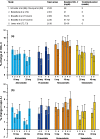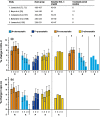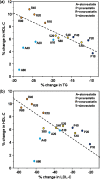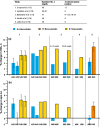Effects of statins on high-density lipoproteins: a potential contribution to cardiovascular benefit
- PMID: 18553127
- PMCID: PMC2493531
- DOI: 10.1007/s10557-008-6113-z
Effects of statins on high-density lipoproteins: a potential contribution to cardiovascular benefit
Abstract
Purpose: The objective was to systematically review clinical trial data on the effects of statins on high-density lipoproteins (HDL) and to examine the possibility that this provides cardiovascular benefits in addition to those derived from reductions in low-density lipoproteins (LDL).
Methods: The PubMed database was searched for publications describing clinical trials of atorvastatin, pravastatin, rosuvastatin, and simvastatin. On the basis of predefined criteria, 103 were selected for review.
Results: Compared with placebo, statins raise HDL, measured as HDL-cholesterol (HDL-C) and apolipoprotein A-I (apo A-I); these elevations are maintained in the long-term. In hypercholesterolemia, HDL-C is raised by approximately 4% to 10%. The percentage changes are greater in patients with low baseline levels, including those with the common combination of high triglycerides (TG) and low HDL-C. These effects do not appear to be dose-related although there is evidence that, with the exception of atorvastatin, the changes in HDL-C are proportional to reductions in apo B-containing lipoproteins. The most likely explanation is a reduced rate of cholesteryl ester transfer protein (CETP)-mediated flow of cholesterol from HDL. There is some evidence that the statin effects on HDL reduce progression of atherosclerosis and risk of cardiovascular disease independently of reductions in LDL.
Conclusion: Statins cause modest increases in HDL-C and apo A-I probably mediated by reductions in CETP activity. It is plausible that such changes independently contribute to the cardiovascular benefits of the statin class but more studies are needed to further explore this possibility.
Figures





References
-
- Miller NE, Thelle DS, Forde OH, Mjos OD. The Tromsø Heart-Study. High-density lipoprotein and coronary heart-disease: a prospective case-control study. Lancet. 1977;1:965–968. - PubMed
-
- Assmann G, Schulte H, von Eckardstein A, Huang Y. High-density lipoprotein cholesterol as a predictor of coronary heart disease risk. The PROCAM experience and pathophysiological implications for reverse cholesterol transport. Atherosclerosis. 1996;124:S11–S20. - PubMed
-
- Gordon DJ. Factors affecting high-density lipoproteins. Endocrinol Metab Clin N Am. 1998;27:699–709. - PubMed
-
- Walldius G, Jungner I, Holme I, Aastveit AH, Kolar W, Steiner E. High apolipoprotein B, low apolipoprotein A-I, and improvement in the prediction of fatal myocardial infarction (AMORIS study): a prospective study. Lancet. 2001;358:2026–2033. - PubMed
-
- Von Eckardstein A, Langer C, Engel T, et al. ATP binding cassette transporter ABCA1 modulates the secretion of apolipoprotein E from human monocyte-derived macrophages. FASEB J. 2001;15:1555–1561. - PubMed
Publication types
MeSH terms
Substances
LinkOut - more resources
Full Text Sources
Medical
Miscellaneous

